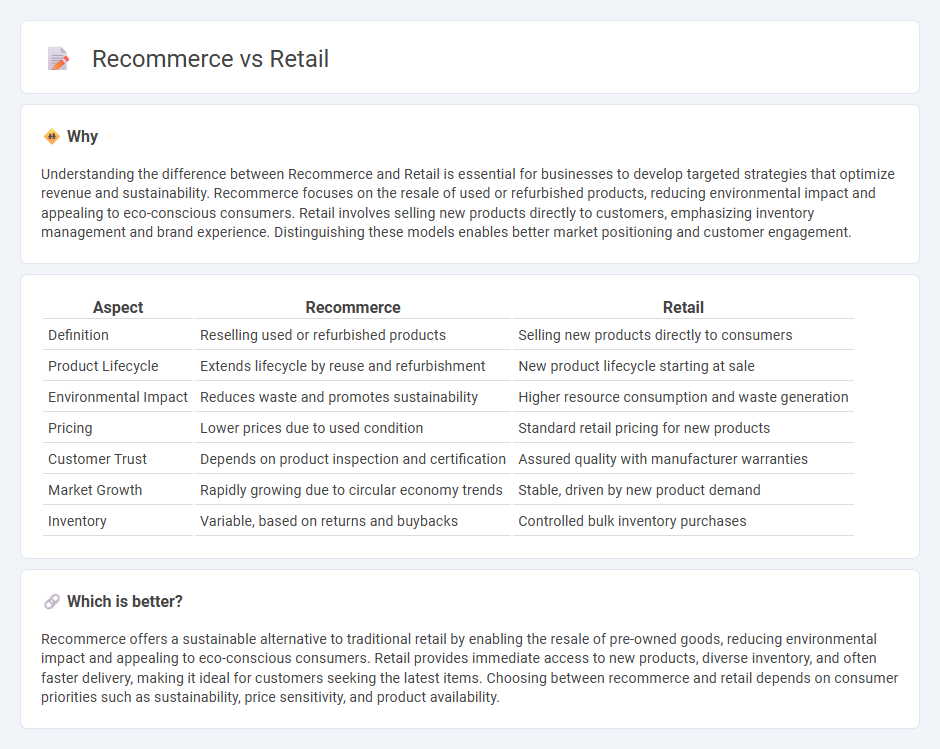
Recommerce leverages the resale of pre-owned products, focusing on sustainability and cost-effectiveness, while traditional retail primarily deals with the sale of new goods from manufacturers to consumers. The recommerce market is rapidly growing, projected to reach $77 billion by 2025, driven by consumer demand for eco-friendly shopping options and circular economy principles. Explore the evolving dynamics between recommerce and retail to understand their impact on consumer behavior and market trends.
Why it is important
Understanding the difference between Recommerce and Retail is essential for businesses to develop targeted strategies that optimize revenue and sustainability. Recommerce focuses on the resale of used or refurbished products, reducing environmental impact and appealing to eco-conscious consumers. Retail involves selling new products directly to customers, emphasizing inventory management and brand experience. Distinguishing these models enables better market positioning and customer engagement.
Comparison Table
| Aspect | Recommerce | Retail |
|---|---|---|
| Definition | Reselling used or refurbished products | Selling new products directly to consumers |
| Product Lifecycle | Extends lifecycle by reuse and refurbishment | New product lifecycle starting at sale |
| Environmental Impact | Reduces waste and promotes sustainability | Higher resource consumption and waste generation |
| Pricing | Lower prices due to used condition | Standard retail pricing for new products |
| Customer Trust | Depends on product inspection and certification | Assured quality with manufacturer warranties |
| Market Growth | Rapidly growing due to circular economy trends | Stable, driven by new product demand |
| Inventory | Variable, based on returns and buybacks | Controlled bulk inventory purchases |
Which is better?
Recommerce offers a sustainable alternative to traditional retail by enabling the resale of pre-owned goods, reducing environmental impact and appealing to eco-conscious consumers. Retail provides immediate access to new products, diverse inventory, and often faster delivery, making it ideal for customers seeking the latest items. Choosing between recommerce and retail depends on consumer priorities such as sustainability, price sensitivity, and product availability.
Connection
Recommerce enhances retail by enabling the resale of pre-owned goods, driving sustainability and reducing waste while expanding inventory options. Retailers benefit from recommerce through increased customer engagement and access to new revenue streams via trade-in programs and refurbished product sales. This synergy supports circular economy models, fostering brand loyalty and meeting consumer demand for affordable, eco-friendly shopping alternatives.
Key Terms
Brick-and-Mortar
Brick-and-mortar retail stores face growing competition from the recommerce market, which emphasizes the resale of pre-owned goods through physical locations. Recommerce leverages sustainability trends and cost-conscious consumers by offering quality used products, often supported by certification and warranty programs. Explore how brick-and-mortar retailers can adapt to recommerce strategies to enhance customer engagement and boost revenue.
Resale
Resale in recommerce leverages the value of previously owned goods, emphasizing sustainability and cost-effectiveness over traditional retail's focus on new products. Recommerce platforms optimize product lifecycle management through refurbishment, authentication, and quality assurance, driving consumer trust and circular economy benefits. Explore how recommerce reshapes retail by promoting resale as a strategic business model.
Circular Economy
Retail primarily involves the sale of new products to consumers, contributing to linear consumption patterns that often lead to increased waste generation. Recommerce centers on the resale, refurbishment, and repurposing of pre-owned goods, promoting resource efficiency and reducing environmental impact by extending product lifecycles. Explore how recommerce strategies drive circular economy principles and reshape sustainable consumption models.
Source and External Links
What Is Retail? Definition & Guide (2025) - Shopify - Retail is the process of selling goods or services directly to consumers for personal use, occurring in physical stores, online, or other channels, encompassing various business types such as supermarkets and ecommerce sites.
Retail - Wikipedia - Retail refers to selling goods and services to consumers in smaller quantities, acting as the final link in the supply chain, with a history from itinerant peddlers to modern omnichannel approaches combining brick-and-mortar and online sales.
What Is Retail? - Erply - Retail is defined as the sale of goods or services from businesses to consumers for personal use, where retailers buy from wholesalers or manufacturers and sell in small quantities to end users.
 dowidth.com
dowidth.com